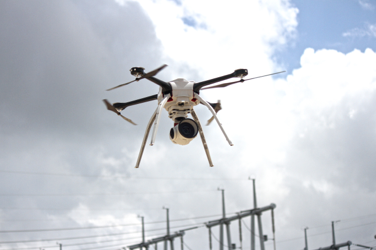These are interesting times when it comes to inspection technology in the process industries. With the advent of big data, mobile and wireless technology, and various other technological advances, we thought it would be a good idea to provide a recap on some of the new technologies that have been covered in Inspectioneering Journal.
Unmanned Aerial Vehicles
 Recently, we've done quite a bit of coverage relating to unmanned aerial vehicles (UAVs), also commonly referred to as drones. They've stirred up quite a bit of discussion in the industry lately, for good reason: UAVs have the potential to make certain types of inspections safer and more efficient. As the regulatory landscape becomes clearer, they will continue to see even greater use.
Recently, we've done quite a bit of coverage relating to unmanned aerial vehicles (UAVs), also commonly referred to as drones. They've stirred up quite a bit of discussion in the industry lately, for good reason: UAVs have the potential to make certain types of inspections safer and more efficient. As the regulatory landscape becomes clearer, they will continue to see even greater use.
This type of inspection involves using a UAV to reach areas that would otherwise be difficult or dangerous. UAVs tend to have high-resolution cameras which allow them to get close-up views of a structure, even from a great distance. Because of this, they are often used for visual inspection. They are able to perform cheap, quick, and easy inspection of structures such as flare stacks and cooling towers.
Radio Frequency Identification (RFID)
Radio Frequency Identification (RFID) technologies have been around for some time now. However, they have yet to be fully implemented in the process industries. RFID technology has the potential to streamline the current system of information handling and data transfer.
RFID involves the use of tags embedded inside of tools or assets. These tags can read and store information. Because the asset itself contains the information, lifecycle management becomes faster and easier. The information can include specifications, maintenance records, installation information, and location history. Because the RFID tag is in the asset, the information can't get lost, associated with the wrong equipment, or worn off. This allows for the data to be available for quick and easy retrieval.
Predictive NDE Sensors
Organizations are currently developing several advanced material property sensors. These will be able to measure several through-thickness related issues in real time.
It is possible to combine these new sensors with common wireless technology. This makes it possible to monitor and upload material property data over time. This technology could be used to detect changes in hydrogen content in real time, allowing us to predict when and where hydrogen damage will occur. As it's collected, this information can then be relayed to the appropriate people via the internet.
Predictive inspections have the potential to detect damage long before it traditional inspections could. This can save companies time and money and lead to improved safety.
Conclusion
These technologies are but a small sample of the myriad new developments in our industry. The gradual adoption of these new technologies may lead to new challenges, but over time their adoption will lead to a safer workplace.
We'll continue to cover new and emerging technologies in Inspectioneering Journal as they develop. Stay tuned!

















Comments and Discussion
There are no comments yet.
Add a Comment
Please log in or register to participate in comments and discussions.